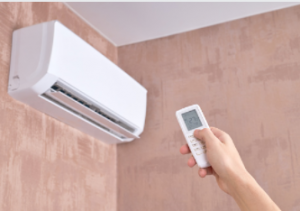
A mini-split air conditioning system operates similarly to a bigger central / split air conditioning system functions: It takes cool air out of an outside environment and heats that air back inside the environment. However, a mini-split air conditioning unit is quite different from a regular central air conditioning unit since it is normally designed specifically for smaller settings. The benefits of these types of units are that they are easier to install, can operate silently, and can be placed almost anywhere without the worry of running wires all over the place. However, the downside to a mini-split air conditioning system is that many of these units require more electricity than normal air conditioning units.
Heat Pumps can be installed in a fujitsu split system to improve efficiency. Several different types of heat pumps can be used, and each has its advantages and disadvantages. The most efficient of these units is a forced-air heat pump; these units have their fans that force hot air through the system, with the hot air circulating through the system through a blanket or by using a furnace to force the hot air around the room. These are by far the most energy-efficient units, but some models of these are extremely loud due to the forced-air technology.
These units run on AC (Amateur Automatic Control) and can also be split air conditioning systems, sometimes referred to as ducted systems. These units can be installed both in and outside the home and are often used in green buildings and environmentally friendly buildings. The units themselves are installed inside the building, and they do not require any cooling and heating ducts, although they may require ventilation ducts if placed outdoors. They are efficient. However, they are susceptible to a phenomenon called refrigeration drift, where one side of the duct is operating at a lower efficiency than the other side.
It is another common type of fujitsu split system which involves vents and ductwork. A duct system includes vents, which allow for air movement throughout a system and direct it into an indoor air quality system. The vents can be made from either thermally broken or pressure-sensitive materials such as a silencer. Thermally broken vents are more effective because when heated, the natural flow of air will cause the vented portion to expand and increase airflow. In contrast, pressure-sensitive vents require that a specific temperature is reached before they work.
The difference between a heating and cooling unit is based on the type of technology used. Heat pumps are heat generators, while air conditioners air cooling systems. A heat pump can create and release heat at a very high rate, while a cooler requires more air input. A split air conditioning system can cool and heat air simultaneously, but generally speaking, they are not the best option for homeowners.
Exhaust and Ventilation System Although you may not directly see this, there are several major differences between an outdoor unit and a split air conditioning system. First of all, an outdoor unit can be placed almost anywhere, whereas most split air conditioning systems are limited to being placed inside. Also, with an outdoor design, you have the option of venting out the waste gases left behind by your heating or cooling unit. An indoor unit does not permit this option. Finally, an outdoor system allows you to change the air filter to clean the air and vent out unwanted gasses, which can be beneficial but can become a bad thing if you are allergic to these gasses.